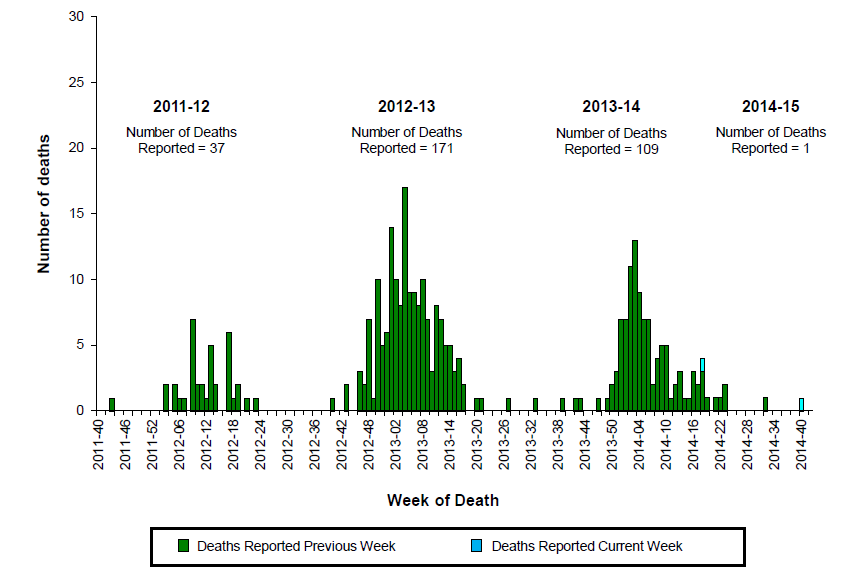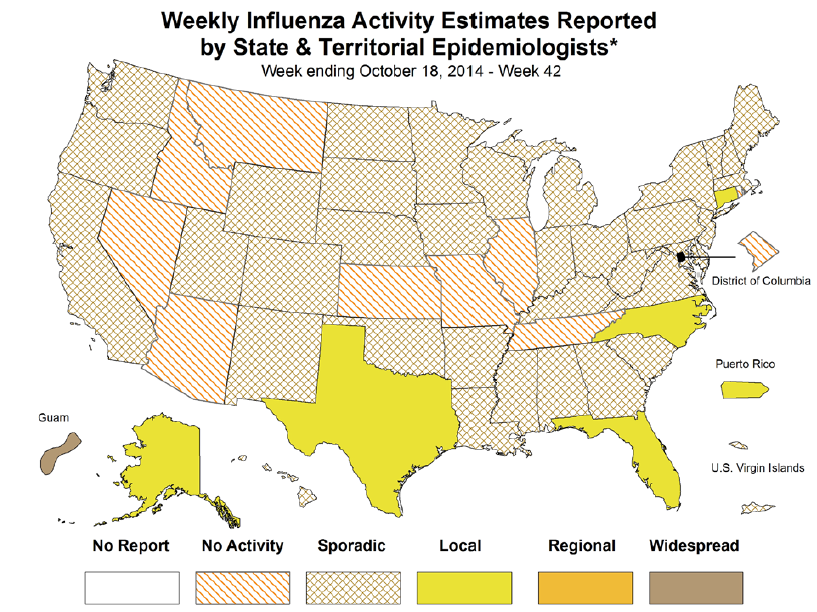Influenza epidemiology and demographics: Difference between revisions
| Line 88: | Line 88: | ||
==Worldwide Influenza== | ==Worldwide Influenza== | ||
*Influenza affects approximately 5 to 10% of adults and 20 to 30% of children | *Influenza affects approximately 5 to 10% of adults and 20 to 30% of children worldwide. | ||
High risk groups such as infants, elderly, and patients with comorbidities, can result in hospitalization and death | *High risk groups such as infants, elderly, and patients with comorbidities, can result in hospitalization and death | ||
*WHO reports 3 to 5 million cases of severe influenza disease, with | *WHO reports 3 to 5 million cases of severe influenza disease, with approximately 250 000 to 500 000 deaths.<ref> {{cite web|url=http://www.who.int/mediacentre/factsheets/fs211/en/| title=WHO Influenza Fact Sheets}}</ref> | ||
==References== | ==References== | ||
Revision as of 15:41, 28 October 2014
|
Influenza Microchapters |
|
Diagnosis |
|---|
|
Treatment |
|
Case Studies |
|
Influenza epidemiology and demographics On the Web |
|
American Roentgen Ray Society Images of Influenza epidemiology and demographics |
|
Risk calculators and risk factors for Influenza epidemiology and demographics |
Editor-In-Chief: C. Michael Gibson, M.S., M.D. [3]; Associate Editor(s)-in-Chief: Alejandro Lemor, M.D. [4]
Overview
Epidemiology and Demographics
Prevalence
Gender
- There is predominance in gender for influenza infection. However, pregnant women are at increased risk of having severe illness and possible complications.
Age
- Influenza viruses cause disease among persons in all age groups.
- Rates of infection are highest among children, but the risks for complications, hospitalizations, and deaths from influenza are higher among persons aged 65 years and older, young children, and persons of any age who have medical conditions that place them at increased risk for complications from influenza.
- During 1990--1999, estimated average rates of influenza-associated pulmonary and circulatory deaths per 100,000 persons were:[1]
- 0.4-0.6 among persons aged 0-49 years
- 7.5 among persons aged 50-64 years
- 98.3 among persons aged 65 years and older.
Mortality
Vaccination[2]
The following data represents the percentage of individuals who received influenza vaccine in the United States:
- 45.2% of children from 6 months to 17 years old received an influenza vaccination during the past 12 months.
- 26.3% of adults aged 18 to 49 years received an influenza vaccination during the past 12 months.
- 42.7% of adults aged 50 to 64 years received an influenza vaccination during the past 12 months.
- 66.5% of adults aged 65 years and over received an influenza vaccination during the past 12 months:
Influenza in the United States
National and Regional Summary of Select Surveillance Components
- The proportion of outpatient visits for influenza-like illness (ILI) was 1.4%, which is below the national baseline of 2.0%. One region reported ILI above their region-specific baseline level.
- Puerto Rico experienced high ILI activity; one state experienced low ILI activity; New York City and 49 states experienced minimal ILI activity and the District of Columbia had insufficient data.
- The geographic spread of influenza in Guam was reported as widespread; Puerto Rico and five states reported local activity; the U.S. Virgin Islands and 36 states reported sporadic activity; and the District of Columbia and nine states reported no influenza activity.
| HHS Surveillance Regions | Out-patient ILI† | % positive for flu‡ | Number of jurisdictions reporting regional or widespread activity§ | 2009 H1N1 | Type A (H3) | Type A (Subtyping not performed) |
Type B | Pediatric Deaths |
|---|---|---|---|---|---|---|---|---|
| Nation | Normal | 4.8% | 1 of 54 | 7 | 267 | 405 | 392 | 1 |
| Region 1 | Normal | 1.6% | 0 of 6 | 0 | 8 | 8 | 4 | 0 |
| Region 2 | Elevated | 1.1% | 0 of 4 | 1 | 17 | 17 | 11 | 0 |
| Region 3 | Normal | 1.7% | 0 of 6 | 0 | 16 | 16 | 69 | 0 |
| Region 4 | Normal | 8.0% | 0 of 8 | 0 | 56 | 290 | 246 | 1 |
| Region 5 | Normal | 2.1% | 0 of 6 | 3 | 28 | 15 | 12 | 0 |
| Region 6 | Normal | 4.3% | 0 of 5 | 2 | 32 | 26 | 69 | 0 |
| Region 7 | Normal | 1.9% | 0 of 4 | 0 | 12 | 15 | 9 | 0 |
| Region 8 | Normal | 1.2% | 0 of 6 | 0 | 15 | 5 | 6 | 0 |
| Region 9 | Normal | 3.2% | 1 of 5 | 1 | 27 | 27 | 19 | 0 |
| Region 10 | Normal | 5.5% | 0 of 4 | 0 | 56 | 4 | 7 | 0 |
|
*HHS regions (Region 1 CT, ME, MA, NH, RI, VT; Region 2: NJ, NY, Puerto Rico, US Virgin Islands; Region 3: DE, DC, MD, PA, VA, WV; Region 4: AL, FL, GA, KY, MS, NC, SC, TN; Region 5: IL, IN, MI, MN, OH, WI; Region 6: AR, LA, NM, OK, TX; Region 7: IA, KS, MO, NE; Region 8: CO, MT, ND, SD, UT, WY; Region 9: AZ, CA, Guam, HI, NV; and Region 10: AK, ID, OR, WA). | ||||||||
 Image obtained from CDC [1] |
 Image obtained from CDC [2] |
Worldwide Influenza
- Influenza affects approximately 5 to 10% of adults and 20 to 30% of children worldwide.
- High risk groups such as infants, elderly, and patients with comorbidities, can result in hospitalization and death
- WHO reports 3 to 5 million cases of severe influenza disease, with approximately 250 000 to 500 000 deaths.[4]